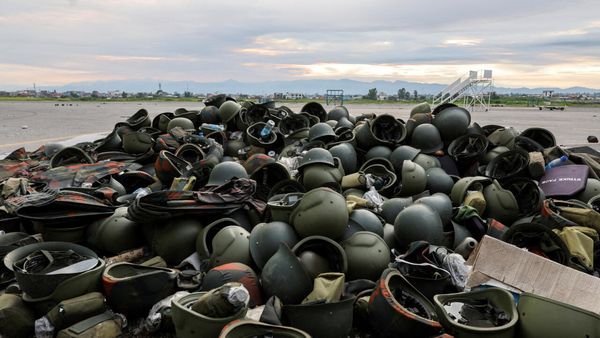
Tall, thin mountain ash trees line the picturesque tracks at Toolangi State Forest, 70km northeast of Melbourne. It’s a few degrees cooler under the trees and the soil is damp underfoot with water that filters through the roots before flowing into the city’s water catchment.
One month ago, before the Andrews government made the shock announcement that it would halt all native forest logging by 31 December, six years earlier than scheduled, the forest was included as part of the state’s native timber reserve. Now the locals who love the forest are asking, what’s next?
Michael Nardella has lived near Toolangi Forest for more than 50 years, and is part of the Toolangi Forest Protection Group.
“Toolangi Forest is very close to my heart,” he says.
The forest adjoins the Kinglake and Yarra Ranges national parks, and Nardella is an advocate of a plan to form the mountain ash forests of the Victorian high country into the Great Forests national park. That proposal would see an additional 355,000 hectares added to the already 170,000 hectares protected by national parks in the region.
“We’ve got such great tourism opportunities here and we’re only 75km from Melbourne’s CBD,” Nardella says.
“I feel privileged to live somewhere where I’ve got forest all around me, and yet most people from the suburbs have no idea of what that’s like. But they can for a day or a weekend.”
Others who care for the forests have warned that the rapid exit from the industry, which was set to wind up by 2030, could leave gaps in forest management, particularly in mitigating bushfire risks.

The Murrindindi Shire council, which covers Toolangi State Forest, says it has sought advice from the state government on what additional assistance will be provided to support the early closure of the industry.
“We also want to know what the state government’s plans are for the ongoing management of our forests to ensure bushfire risks are managed, our forests remain accessible to all, and that emergency services will still have access to the plant and equipment needed to respond to bushfire emergencies, which forestry workers have voluntarily provided up to now,” a council spokesperson said.
Forest Fire Management Victoria chief fire officer, Chris Hardman, says he recognises the contribution that timber industry subcontractors have made to managing bushfire risk in Victoria, and that some will be kept on in that capacity.
“Harvest and haulage contractors will be engaged for [Department of Energy, Environment and Climate Action] and fire management works beyond the end of native timber harvesting, using their valuable skills and equipment as we manage our forests and prepare for and respond to fires,” Hardman says.
“We will assess any needs based on resources available and adjust our response strategy accordingly.”
The closure of the Victorian native timber industry has been long-heralded, but the suddenness still took both the industry and the state-owned VicForests by surprise.
VicForests unveiled its latest timber-release plan, which lists approved areas for timber harvesting, on 1 May, just three weeks before the government announced the shutdown.

Chris Schuringa from the Victorian Forest Alliance, said there was “no need for native forests to be logged.
“Victoria has the largest plantation estate in Australia, yet we export over 90% of this overseas,” she said.
“Small scale agri-forestry and farm forestry, and initiatives like Ceres Fair Wood can provide sustainable alternatives to sourcing hardwood from native forests.”
Karen Stephens, the president of Timber Towns Victoria, disagreed, saying Victoria may now be in the position of having to import timber, “probably from overseas and unsustainable sources.
“Tasmania and New South Wales and these other places don’t harvest trees unless they have a market for it,” she says. “They’ve already got contracts as it is, and there just isn’t enough timber.”
Public servants are now rapidly working to manage both the industry and worker transition and the mammoth land-management task.
An Andrews government spokesperson said that while there would need to be land management works to manage the 1.8m hectares of public land that was previously allocated for logging, “forestry workers, their families and communities are our immediate priority.
“We do not take the decision around an early transition out of native timber harvesting lightly, but the uncertainty from ongoing litigation and severe bushfires cannot continue,” they said.

But not all subcontractors will be sticking around. Some are being offered work in New South Wales and Tasmania – states which, for the time being at least, still have a native timber industry.
Perse Hull and Italia d’Antonio operate North East Logging in Acheron, not far from Alexandra, about 130km northeast of Melbourne. Their home is flanked bymillions of dollar’s worth of logging machinery, with the words ‘ANOTHER INDUSTRY GONE’ painted on the blade of a bulldozer.
Some of those machines were made in order to fulfil a contract with VicForests signed three years ago. That contract still has a year to run, but they are not sure if or how they will be asked to fulfil it, and whether they will get a return on their equipment.
For Hull, whose father also worked in the forestry industry, it’s the family business. After 30 years in the industry, he doesn’t know what else to do.
“We’ll have to go elsewhere,” he says. “We’ve already been in stand-down mode since November, obviously on reduced pay, and we’ve been waiting to see what happens next since then.
“We’re still waiting. There’s just been a complete lack of communication the whole way as to what happens next.”







